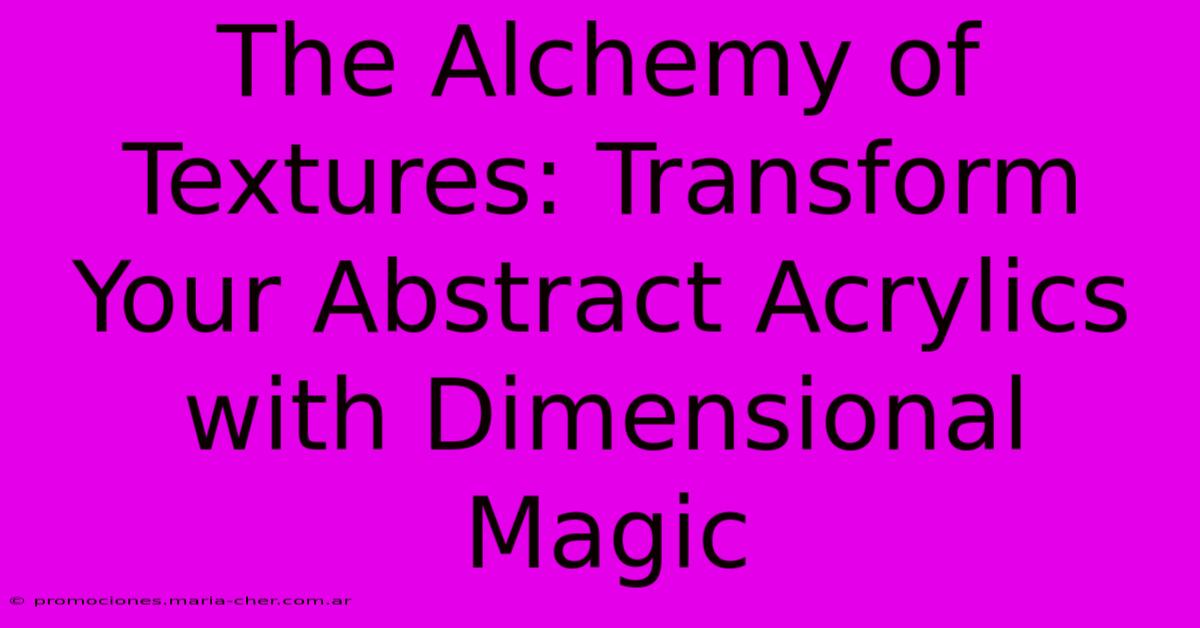The Alchemy Of Textures: Transform Your Abstract Acrylics With Dimensional Magic

Table of Contents
The Alchemy of Textures: Transform Your Abstract Acrylics with Dimensional Magic
Abstract acrylic painting offers a fantastic playground for creativity, but adding texture elevates your work from flat representation to a captivating, three-dimensional experience. This article explores various techniques to infuse your abstract acrylics with dimensional magic, turning your canvases into tactile masterpieces.
Unleashing the Power of Texture in Abstract Art
Texture isn't just about visual interest; it adds depth, complexity, and a unique sensory element to your abstract paintings. It allows you to play with light and shadow in unexpected ways, creating areas of visual intrigue and drawing the viewer's eye across the canvas. By mastering textural techniques, you can significantly enhance the emotional impact and overall artistic expression of your work.
Why Texture Matters in Abstract Acrylic Painting
- Visual Interest: Texture breaks up monotonous surfaces, preventing a flat, lifeless feel.
- Depth and Dimension: It creates a sense of depth, drawing the viewer into the painting.
- Tactile Experience: Depending on the techniques used, the texture can be felt, adding another layer to the viewer's experience.
- Emotional Impact: Different textures evoke different feelings, allowing for more nuanced emotional expression.
- Unique Style: Mastering textural techniques develops your unique artistic voice.
Exploring Diverse Texturing Techniques for Acrylics
The possibilities for adding texture to your acrylic paintings are endless. Here are some popular and effective techniques to experiment with:
1. Impasto Technique: Bold and Dramatic
Impasto, the application of thick layers of paint, is a classic method for creating dramatic texture. Using a palette knife or even your fingers, you can build up layers of paint, creating peaks, valleys, and dynamic surface variations. Experiment with different paint consistencies for varying effects. Key Tip: Use high-quality acrylics that retain their texture as they dry.
2. Collage: Integrating Diverse Materials
Introduce unexpected elements through collage. Incorporate fabric scraps, paper, string, or even found objects to add intriguing textures and patterns. Key Tip: Ensure the adhesive is strong enough to securely hold your chosen materials.
3. Sand and Grit: Natural Textural Elements
Mix sand, coarse grit, or other granular materials into your acrylic paints for a rough, sandy texture. This works particularly well for creating landscapes or evoking a sense of dryness or harshness. Key Tip: Use a quality sealant to protect the textured surface from weathering.
4. Modeling Paste: Sculptural Possibilities
Acrylic modeling paste provides a versatile medium for sculpting textures onto your canvas. Use palette knives, brushes, or even your fingers to shape and mold the paste into various forms. You can then paint over the dried paste for a stunning effect. Key Tip: Allow the modeling paste to dry completely before painting.
5. Stenciling: Precise and Repeating Patterns
Stencils offer a means of creating precise, repeating textures. Use stencils to apply paint, modeling paste, or other mediums in consistent patterns. Key Tip: Experiment with layering stencils for complex patterns.
Enhancing Your Textured Masterpieces
Once you've applied your chosen textures, consider these finishing touches:
- Layering: Build layers of texture for greater depth and complexity.
- Color Mixing: Use color to highlight or subdue your textures.
- Glazing: Apply transparent glazes to add depth and luminosity.
- Varnishing: Protect your finished artwork with a high-quality varnish.
Conclusion: Embark on Your Textural Journey
The alchemy of textures in abstract acrylic painting allows for limitless creativity. By experimenting with these techniques and developing your own approaches, you can transform your artwork from flat images to multi-sensory experiences that captivate and inspire. Don't be afraid to experiment – the beauty of abstract art lies in the freedom of exploration! So, gather your supplies, and unleash your inner texture artist!

Thank you for visiting our website wich cover about The Alchemy Of Textures: Transform Your Abstract Acrylics With Dimensional Magic. We hope the information provided has been useful to you. Feel free to contact us if you have any questions or need further assistance. See you next time and dont miss to bookmark.
Featured Posts
-
Piercing Perfection Achieve A Stunning Upper Ear Lobe Piercing In 5 Easy Steps
Feb 08, 2025
-
Unlock The Gates To 380 Lexington Ave Nyc Where Dreams Take Flight
Feb 08, 2025
-
The Ultimate Guide To Printing Movie Posters That Will Blow Your Mind
Feb 08, 2025
-
Escape The Ordinary Discover The Extraordinary Beauty Of Fresh Flower Garlands
Feb 08, 2025
-
Unlock The Power Of Contrast Discover The Perfect Frame For Black And White Magic
Feb 08, 2025
